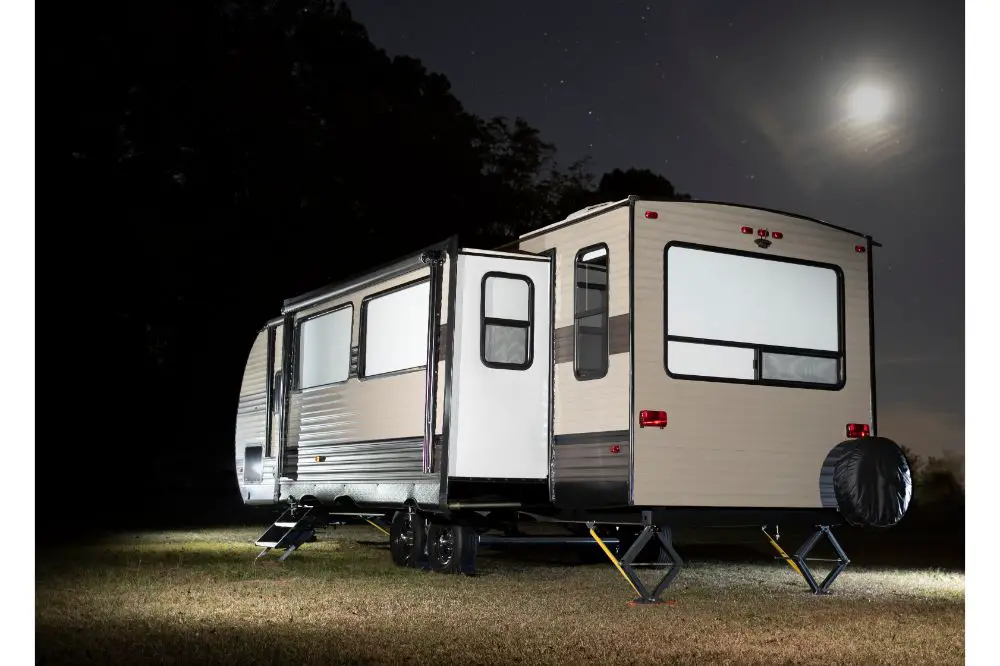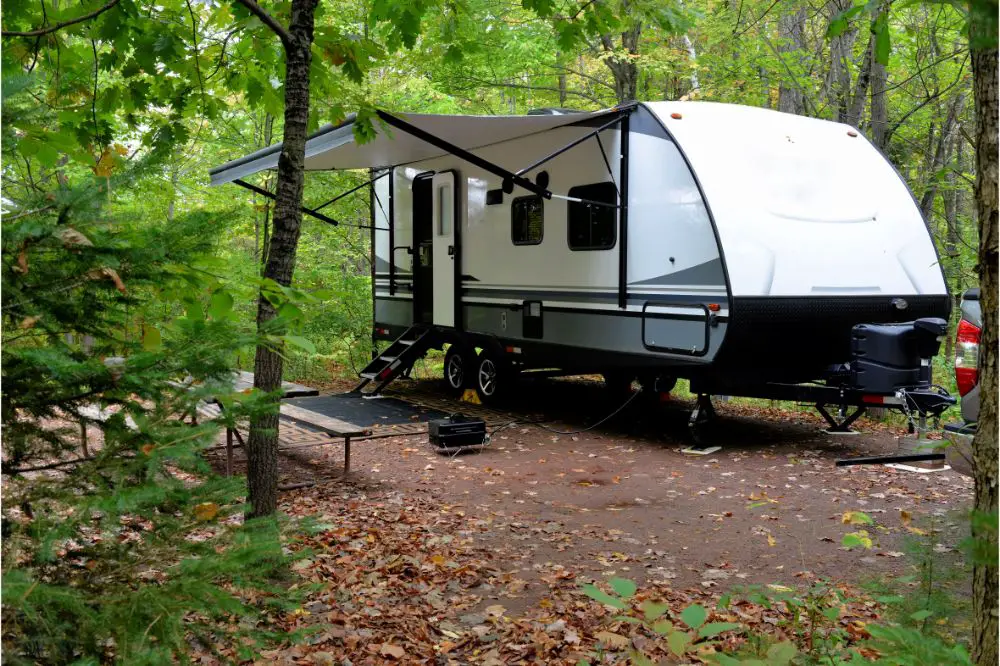Published Date: July 5, 2022
Last Updated on June 22, 2023 by Camper Front
RV and travel trailer ownership is growing in popularity. Being a vehicle owner makes basic roadside maintenance skills vital. Replacing flat tires and general upkeep are some of the most routine maintenance activities you’re likely to encounter. Not knowing how to get your spare tire fitted can become frustrating and even dangerous when you’re on a road trip, so understanding how to jack up an RV trailer is essential.
In this article, we will provide you with a step-by-step walkthrough of a proper trailer jacking technique, a brief overview of the equipment you will need to make the process as simple and painless as possible, and some tips on how to go about all this as safely as possible. So without further ado, let’s take a look at how to jack up an RV trailer safely and efficiently.
Table of Contents
Types of Jacks
As you have probably realized by now, your vehicle jack is the most important piece of equipment required; hence we will discuss this first. While most travel trailer owners widely prefer the bottle jack, other common types may work as well, but knowing the differences and limitations between each will no doubt help you tremendously.
Here are the main types of jacks to keep in mind:
Bottle Jacks
Bottle jacks are more like gas cylinders, despite the name. And on average, it is around a foot in height and 18 pounds in weight. There are various options available, so be sure to choose one suitable for the weight of your trailer and your desired lifting height. The average lifting capacity of a bottle jack is around 40,000 pounds, and the average lifting height ranges between 9 and 18 inches.
Scissor Jacks
On average, these jacks weigh around 6 pounds with a lifting capacity of around 3,300 pounds. These are very user-friendly jacks but, as the figures suggest, cannot be relied on for heavy lifting. These are much more conducive to lighter motor vehicles and smaller trailers.
Floor Jacks
Floor jacks are ideal when working on your trailer maintenance or changing a flat tire at home. They’re large and heavy, which makes them difficult to take around with you, but they have excellent lifting weights and are extremely sturdy. These are the types of jacks you will find in vehicle service centers and shops, and we highly recommend keeping one of these where you store your RV.

Equipment Required
You will not be able to complete the task with just a jack, though. There are many things involved in jacking up an RV trailer as the unit is weighty and requires extra processes.
Here’s a list of the additional equipment required to jack your RV trailer easily and safely.
- Jack – Preferably a bottle jack.
- Jack stand – While these are not entirely essential, they are safer than other make-shift options, especially when the ground is somewhat uneven.
- Extensions – The average ground clearance of a trailer is between 16 and 25 inches. An extender may be necessary to achieve the desired height depending on the tire size and to ensure that you’re not trying to squeeze into an uncomfortable tight space.
- Wheel chocks – These will be used for securing your trailer.
- Socket or lug wrench
- Spare tire – If that’s the reason for jacking.
- Breaker bar
- Trailer aid – Ramp for larger trailers.
Now that you have all the necessary tools that are required to jack up an RV trailer, let’s discuss how to use them properly and safely.
How to Jack Up An RV Trailer
While there are many types of travel trailers, the main consideration is how many axles they have when it comes to jacking them up. They are usually single-axle or dual-axle trailers, and jacking either is fairly similar, provided you have considered the weight difference. Reading and understanding the operational manual is all the more important and necessary.
Step 1 – Try to park on solid, level ground. If this is not possible, you may need to position the trailer aid ramp to assist in keeping the wheels locked.
Step 2 – Ensure your tow vehicle is attached, switched off, and the emergency brake is activated. Chock the rear wheels if possible.
Step 3 – Next, you will chock the trailer wheels on the opposite side from where you intend to elevate. In the case of the dual axle trailer, you will need to place the tire ramp in front of an inflated tire for stability and ensure that the jack stand does not get into the wheel well. If you fit a spare tire, you will want to loosen the nuts on the affected tire while still on the ground. It would be best if you also took the spare tire off the back of the trailer at this point.
Step 4 – Place the jack on the frame just behind the axle or rear axle in the case of a dual-axel trailer. Do not place the jack below any other suspension parts, torsion axles, or leaf springs! Doing so can cause serious damage to these pressurized parts and are costly to fix. Once the jack is positioned, you can safely start jacking your trailer.
Step 5 – Position the jack stands. Once positioned, you can lower the trailer slowly onto the jack stands for stability. This is not essential for single-axle trailers but still recommended.
Step 6 – Complete removing the affected tire and inserting the spare tire or completing necessary maintenance. If you add a spare tire, you should not tighten the nuts fully just yet. Wait until the trailer is back on solid ground before doing so.
Step 7 – Work in reverse order to complete setting the trailer back on the ground.
In addition to just single and dual-axle trailers, this technique can also be used on other variants such as fifth wheelers, tandem axle travel trailers, and campers.
Safety Tips to Jack Up an RV Trailer
If you’re new to jacking up your travel trailer, it’s always important to ensure that you take some safety precautions while you master the process. Here are a few to consider:
- Until you’re confident in jacking your trailer up yourself, it is a good idea to have someone else present in case of an emergency, such as if the trailer starts to slip off the stands.
- Try to ensure that the trailer is on even and solid ground. Uneven or soft ground may increase the likelihood of movement.
- Keep children and pets away from the work area.
- Where possible, try to use protective eyewear to keep debris out of your eyes while jacking.
- Apply the handbrake and parking brake before jacking up the trailer. Check twice if necessary.
- Favor jack stands over other alternatives such as wood blocks or bricks.
Conclusion
Jacking up your travel trailer can be tricky and potentially dangerous if you’re new to the process. Ensuring that you have the right equipment and working in a structured sequence can significantly reduce the effort and risk required to jack up an RV trailer.
For larger trailers, such as dual axels, there may be a need for additional equipment, such as a tire aid ramp, which will help save storage space while lowering the trailer’s weight. Learning how to jack your trailer will become easier by reading and understanding the operations manual and practicing.

